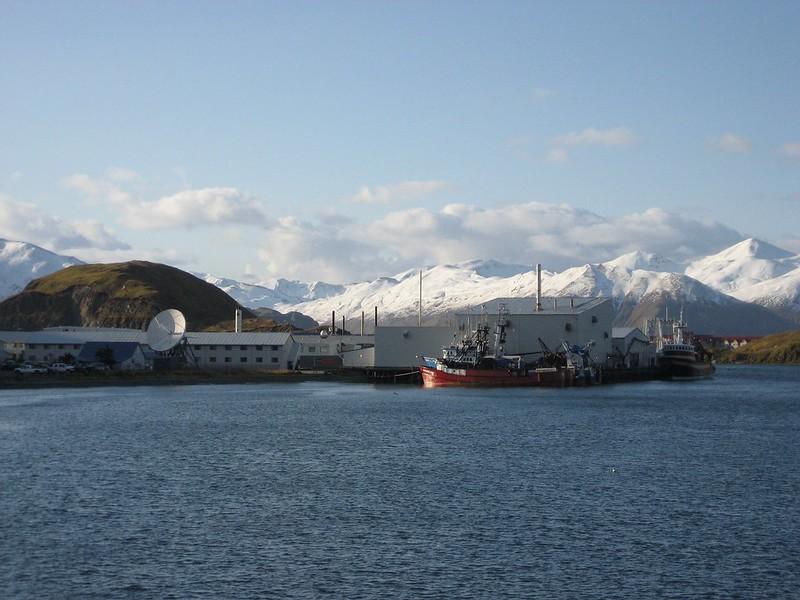Report: Alaska Seafood Industry Suffered a USD 1.8 Billion Loss from 2022 to 2023

Fishing boats, processing plants, Dutch Harbor, Alaska. (Photo: Michael Theberge, 2nd Mate Coastal Merchant / NOAA Photo Library).
In the past several years, the Alaska seafood industry has experienced a downturn and major changes. A new snapshot estimates that the Alaska fishing industry saw a 50 percent decline in profitability in the period 2021-2023.
Economists estimate that the Alaska seafood industry suffered a USD 1.8 billion loss in the period 2022-2023.
The Alaska fishing industry furthermore saw a 50 percent decline in profitability in the period 2021-2023.
The findings are published in the Alaska Seafood Snapshot, released by NOAA Fisheries, which is responsible for the stewardship of the USAs ocean resources and their habitat. NOAA is the National Oceanic and Atmospheric Administration.
Concerned seafood industry members requested that NOAA Fisheries undertake an independent analysis after the 2023 downturn in the sector.
“Commercial fisheries have flourished in Alaska for generations, shaping social structures, cultural identity, and robust local economies. Beyond the economic impacts, the decline of fisheries in the region threatens a way of life, sense of place, community, and identity,” says Steve Kasperski, lead author of the snapshot and an economist with the Alaska Fisheries Science Center.
Downturn in the fisheries
The report provides a snapshot of the current state of the Alaska seafood industry, which it states "has undergone tremendous changes in the past several years".
Some of the key findings that the economists found was that, starting in 2022, the industry experienced higher costs associated with increased wages, higher energy prices, as well as higher interest rates.
Revenues also decreased in 2023 due to declining prices for every major species group.
In the report, other recent challenges faced by the Alaska seafood industry are further elaborated. This a.o. involves changed retail and consumer behavior in the post-pandemic years, challenges for Alaska fishermen such as increased competition abroad, as well as the impacts of climate change.
Some of the recent challenges faced by the Alaska seafood industry relates to:
- Lower Seafood Prices
- Residual COVID Impacts
- Trade and Tariffs
- Fisheries Disasters
- Processor Employment and Plant Closures
Source: NOAA Fisheries’ industry snapshot report.
With regards to trade and tariffs, the authors for instance point to high levels of Russian exports, particularly of pollock, cod, salmon, and crab. These directly compete with Alaska seafood, the report notes, and exert downward pressure on prices received by Alaska producers.
The report also highlights lower labor and operating costs in production and processing abroad, which hurt the competitive standing. Other factors affecting competitiveness include international trade barriers, strengthening U.S. dollar, inflation, which affects consumer demand for higher priced seafood products, and declines in seafood processing jobs and plant closures in the United States.
“Reverberated across the country”
“The Alaska seafood industry is a major contributor to the U.S. seafood sector, " adds Robert Foy, director of the Alaska Fisheries Science Center, in connection with the report.
According to NOAA, the Alaska region fisheries produce about half the fish caught in U.S. waters, contributing more than USD 7 billion to the national economy.
Foy further adds that the social and economic ramifications of Alaska’s losses have "reverberated down the West Coast and across the country."
"The revenue losses between 2022 and 2023 are estimated to be a USD 1.8 billion shock to the Alaska economy, resulting in a loss of more than 38,000 fishing and non-fishing jobs in the United States and a loss of USD 4.3 billion in total U.S. output," the report concludes.
The most affected states, which includes Alaska, Washington, Oregon, and California, saw a combined loss of USD 191 million in state and local tax revenues.
The State of Alaska also recently set up a Joint Legislative Seafood Industry Task Force to respond to the Alaska seafood crisis. Their report is expected in January 2025.

